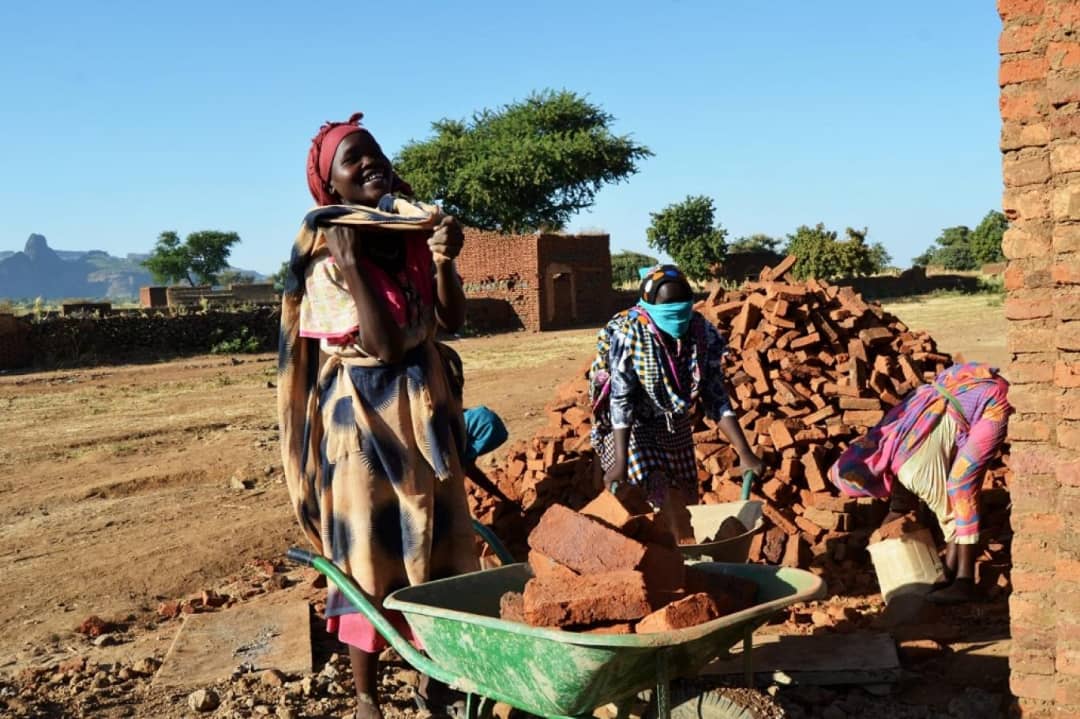With Sudanese displaced persons returning to their towns and villages reclaimed by the army from the Rapid Support Forces, they were met with a painful reality: their homes were either completely or partially destroyed due to the battles between the two sides.
Despite the scarcity of resources among most returnees, they had no choice but to begin repairing the war-ravaged homes using the most affordable means possible. As a result, several construction-related trades have recently flourished, particularly the traditional craft of brick kiln making. This age-old trade, inherited from forefathers, is widely practiced along the Nile River, especially in the Al-Jarif suburb southeast of Khartoum, benefiting from the Nile silt brought by seasonal floods.
Ongoing Resilience
The craft of brick kiln making dates back to the Turkish rule in Sudan (1821–1885) and evolved during the British colonial era (1899–1956). The residents of Al-Jarif learned the trade through traditional methods and became highly skilled in it.
Despite Sudan’s industrial advancements and the emergence of fire bricks and cement blocks—now widely used in large-scale construction projects—and despite investment projects established along the Nile, the “brick kiln” industry has endured, even amid war. Sudanese continue to prefer kiln-made bricks for their ability to absorb moisture. Moreover, the industry provides employment to over 500 workers, including kiln laborers, loaders, and drivers, producing nearly a billion bricks annually.
A Struggling Industry
Al-Taher Abdelkarim, a brick kiln owner in Al-Jarif, explains:
“Brick kiln making is a traditional trade passed down through generations. It has long been a source of livelihood for extended families. Despite holding an advanced academic degree, I can’t imagine doing anything else due to my deep-rooted connection to this work. Though the war forced us to pause for a while, we quickly resumed to meet the growing demand. Everyone returning from displacement finds their home in ruins, requiring repairs after over 22 months of relentless air and artillery bombardment.”
Abdelkarim continues:
“Building a brick kiln starts by digging a two-meter-deep pit used for firing bricks. The process begins with mixing the soft Nile silt left from flooding with cow dung, then placing the mixture into iron molds—a step known as ‘brick pressing’. The bricks are left to dry slightly, then stacked in the pit. Proper stacking requires experience, as any imbalance may cause collapse and loss. Each kiln holds about 100 bricks, and finally, workers ignite a fire that burns for four hours.”
He adds:
“The work is tough and demanding. Most workers are migrants from faraway regions seeking livelihood. They must monitor the kilns under the scorching sun until the bricks turn from mud to red.
Right now, there’s a huge demand for bricks, but we face some challenges—mainly a labor shortage due to displacement since the war began, and changes in the firing process with the introduction of gas. Still, we’re striving to overcome these difficulties.”
Abdelkarim notes:
“Just as red bricks were used in city infrastructure since the Turkish era—including the Republican Palace built in 1832—we expect them to be used in rebuilding all that the war has destroyed.”
Demand and Popularity
Azhari Abdulrahim, a building materials trader, says:
“With the relative stability and calm following the army’s retaking of large swaths of conflict-affected towns and villages, citizens have returned hoping to resume normal life. Thus, we expect a surge in construction activity, especially in demand for red kiln bricks.”
He adds:
“From my market experience, most Sudanese prefer kiln bricks due to their ability to absorb moisture caused by climate fluctuations. In fact, they get stronger the more they are exposed to water, making them last for hundreds of years. Most buildings in Khartoum, other states, and public and private institutions in Sudan are built with red bricks. Though cement blocks gained popularity before the war, kiln bricks remain the top choice.”
Abdulrahim points out:
“Traditional kiln bricks are more affordable and more popular compared to the industrially produced bricks, which the average person cannot rely on to build their homes amid the current economic collapse.”
Environmental Degradation
Hilaliya Osman, a resident of Al-Jarif, comments:
“While kiln bricks are urgently needed to repair war-damaged homes, we in Al-Jarif—the main hub for this trade—suffer from the smoke caused by burning firewood. It negatively impacts residents’ health, especially those with allergies, heart disease, or chronic conditions like arterial narrowing. The environmental damage from the burning waste is also severe.”
She adds:
“Before the war, we filed complaints with the local authorities, but they remained silent and ignored the dangers of kilns near residential neighborhoods. This trade is both environmentally harmful and illegal.”
Osman warns:
“After long periods of displacement, returning residents are already physically fragile. The revival of intense brick production near their homes will only worsen their suffering.”
